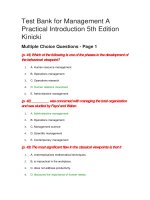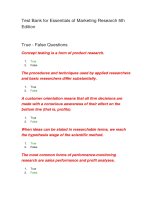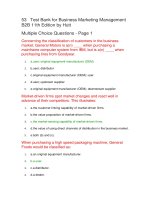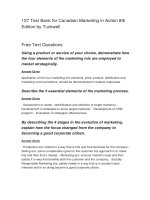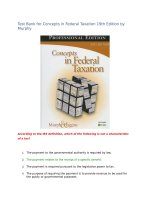Test bank for psychology a concise introduction 5th edition by griggs
Bạn đang xem bản rút gọn của tài liệu. Xem và tải ngay bản đầy đủ của tài liệu tại đây (109 KB, 22 trang )
Name: __________________________ Date: _____________
1. The biological perspective most directly emphasizes _____, and the cognitive perspective most directly emphasizes _____.
A) the brain and nervous system; the environment
B) the brain and nervous system; mental processes
C) mental processes; the environment
D) the environment; mental processes
2. The biological perspective is to _____ as the cognitive perspective is to _____.
A) hardware; software
B) software; hardware
C) internal factors; external factors
D) external factors; internal factors
3. The behavioral perspective focuses on _____, and the sociocultural perspective focuses on _____.
A) both observable behavior and mental processes; both observable behavior and mental processes
B) both observable behavior and mental processes; observable behavior only
C) observable behavior only; both observable behavior and mental processes
D) observable behavior only; observable behavior only
4. One disadvantage of the case study method is that it:
A) is difficult to recruit a large number of participants.
B) does not provide findings that can be generalized.
C) is not useful for generating hypotheses.
D) involves traveling to multiple natural settings.
5. Random assignment is to _____ as random sampling is to _____.
A) generalize; control
B) control; generalize
C) large groups; small groups
D) small groups; large groups
6. Which statement about scatterplots is TRUE?
A) If points are scattered randomly, one variable does not predict another.
B) If data points fall on a line from the bottom right to the top left, there is a positive relationship.
C) If data points fall on a line from the bottom left to the top right, there is a negative relationship.
D) If points are scattered randomly, there is a negative relationship.
7. Which is NOT a reason for researchers to use a double-blind procedure when an experiment includes a placebo group?
A) The double-blind procedure controls for experimenter expectation.
B) An experimenter may treat control and treatment groups differently, thus influencing their behavior.
C) An experimenter may record and interpret the two groups' behaviors differently.
D) The double-blind procedure assures that participants do not know which group they are assigned to.
8. Measures of central tendency provide information about _____, and measures of variability provide information about _____.
A) how spread out the scores are; the typical score
B) the typical score; how spread out the scores are
C) the percentile rank of scores; whether or not the distribution is skewed
D) whether or not the distribution is skewed; the percentile rank of scores
9. Why does the normal distribution have a bell shape?
A) because all scores occur with equal frequency
B) because low scores are more frequent than high scores
C) because high scores are more frequent than low scores
D) because scores near the mean are most frequent and extreme scores are rare
10. In a distribution of test scores, there are a few scores that are much lower than the others. This is an example of a _____skewed distribution in which the mean is _____ than the median.
A) right; greater
B) right; less
C) left; greater
D) left; less
Page 1
Full file at />
11. Which major research perspective focuses on conditioning by external environmental events as the major cause of our
behavior?
A) biological
B) cognitive
C) behavioral
D) sociocultural
12. Which procedure would be BEST for obtaining a representative sample of the students at your school?
A) sampling randomly among students in the student union
B) sampling randomly among students studying in the library
C) sampling randomly among the students who belong to Greek organizations
D) sampling randomly from a list of all the students enrolled at your school
13. Which research method allows the researcher to draw cause-effect conclusions?
A) descriptive methods
B) correlational studies
C) experimental research
D) observational techniques
14. Height and weight are _____ correlated; elevation and temperature are _____ correlated.
A) positively; positively
B) positively; negatively
C) negatively; positively
D) negatively; negatively
15. Which correlation coefficient indicates the STRONGEST relationship?
A) +.75
B) –.81
C) +1.25
D) 0.00
16. Manipulate is to measure as _____ is to _____.
A) positive correlation; negative correlation
B) negative correlation; positive correlation
C) independent variable; dependent variable
D) dependent variable; independent variable
17. In an experiment, the _____ group participants receive an inactive treatment but are told that the treatment will help them.
A) experimental
B) control
C) placebo
D) third-variable
18. The most frequently occurring score in a distribution of scores is the _____, and the average score is the _____.
A) mode; mean
B) mean; mode
C) median; mean
D) mean; median
19. About _____ percent of the scores in a normal distribution are between –1 standard deviation and +1 standard deviation of
the mean.
A) 34
B) 68
C) 95
D) 99
20. In a left-skewed distribution, the mean is _____ than the median; in a right-skewed distribution, the mean is _____ than the
median.
A) greater; greater
B) greater; less
C) less; greater
D) less; less
21. Shere Hite's failure to use _____ resulted in misleading findings for her women and love survey study.
A) a placebo group
B) a double-blind procedure
C) random assignment
D) random sampling
Page 2
Full file at />
22. Professor Jones noticed that the distribution of students' scores on his last biology exam had an extremely small standard
deviation. This indicates that the:
A) exam was given to a very small class of students.
B) exam was a poor measure of the students' knowledge.
C) students' scores tended to be very similar to one another.
D) students' mean exam score was less than the median exam score.
23. In a normal distribution, the percentile rank for a score that is 1 standard deviation below the mean is roughly _____ percent.
A) 16
B) 34
C) 68
D) 84
24. Dian Fossey's study of gorillas is an example of a:
A) naturalistic observation.
B) participant observation.
C) naturalistic observation that turned into participant observation.
D) case study.
25. Which type of scatterplots depicts a weak, negative correlation?
A) a lot of scatter with data points going from top left to bottom right
B) very little scatter with data points going from top left to bottom right
C) a lot of scatter with data points going from bottom left to top right
D) very little scatter with data points going from bottom left to top right
Test Bank for Psychology A Concise Introduction 5th Edition by Griggs
26. A study examining Full
how other
people
affect one's behavior is MOST likely guided by which major research perspective?
file at
/>A) biological
B) behavioral
C) cognitive
D) sociocultural
27. The biological approach emphasizes _____ factors in explaining behavior, and the cognitive perspective emphasizes _____
factors in explaining behavior.
A) internal; internal
B) external; internal
C) internal; external
D) external; external
28. Operant conditioning is an element of the _____ perspective and it involves learning the association between _____.
A) cognitive; two environmental events
B) cognitive; behavior and its environmental consequences
C) behavioral; two environmental events
D) behavioral; behavior and its environmental consequences
29. A case study is an example of _____ research.
A) experimental
B) descriptive
C) survey
D) correlational
30. Which statement about random sampling is TRUE?
A) Random sampling is used to assign participants to experimental and control groups.
B) Random sampling does not provide a representative sample of the population being studied.
C) In random sampling, each individual in the population has the same chance of being in the sample.
D) In random sampling, researchers recruit their friends and associates at random.
31. If you want to predict the relationship between age and intelligence quotient (IQ), which research method would be BEST?
A) a correlational study
B) a case study
C) a controlled experiment����������������������������������������������������������������������������������������������������������������������������������������������������������������������������������������������������������������������������������������������������������������������������������������������������������������������������������������������������������������������������������������������������������������������������������������������������������������������������������������������������������������������������������������������������������������������������������������������������������������������������������������������������������������������������������������������������������������������������������������������������������������������������������������������������������������������������������������������������������������������������������������������������������������������������������������������������������������������������������������������������������������������������������������������������������������������������������������������������������������������������������������������������������������������������������������������������������������������������������������������������������������������������������������������������������������������������������������������������������������������������������������������������������������������������������������������������������������������������������������������������������������������������������������������������������������������������������������������������������������������������������������������������������������������������������������������������������������������������������������������������������������������������������������������������������������������������������������������������������������������������������������������������������������������������������������������������������������������������������������������������������������������������������������������������������������������������������������������������������������������������������������������������������������������������������������������������������������������������������������������������������������������������������������������������������������������������������������������������������������������������������������������������������������������������������������������������������������������������������������������������������������������������������������������������������������������������������������������������������������������������������������������������������������������������������������������������������������������������������������������������������������������������������������������������������������������������������������������������������������������������������������������������������������������������������������������������������������������������������������������������������������������������������������������������������������������������������������������������������������������������������������������������������������������������������������������������������������������������������������������������������������������������������������������������������������������������������������������������������������������������������������������������������������������������������������������������������������������������������������������������������������������������������������������������������������������������������������������������������������������������������������������������������������������������������������������������������������������������������������������������������������������������������������������������������������������������������������������������������������������������������������������������������������������������������������������������������������������������������������������������������������������������������������������������������������������������������������������������������������������������������������������������������������������������������������������������������������������������������������������������������������������������������������������������������������������������������������������������������������������������������������������������������������������������������������������������������������������������������������������������������������������������������������������������������������������������������������������������������������������������������������������������������������������������������������������������������������������������������������������������������������������������������������������������������������������������������������������������������������������������������������������������������������������������������������������������������������������������������������������������������������������������������������������������������������������������������������������������������������������������������������������������������������������������������������������������������������������������������������������������������������������������������������������������������������������������������������������������������������������������������������������������������������������������������������������������������������������������������������������������������������������������������������������������������������������������������������������������������������������������������������������������������������������������������������������������������������������������������������������������������������������������������������������������������������������������������������������������������������������������������������������������������������������������������������������������������������������������������������������������������������������������������������������������������������������������������������������������������������������������������������������������������������������������������������������������������������������������������������������������������������������������������������������������������������������������������������������������������������������������������������������������������������������������������������������������������������������������������������������������������������������������������������������������������������������������������������������������������������������������������������������������������������������������������������������������������������������������������������������������������������������������������������������������������������������������������������������������������������������������������������������������������������������������������������������������������������������������������������������������������������������������������������������������������������������������������������������������������������������������������������������������������������������������������������������������������������������������������������������������������������������������������������������������������������������������������������������������������������������������������������������������������������������������������������������������������������������������������������������������������������������������������������������������������������������������������������������������������������������������������������������������������������������������������������������������������������������������������������������������������������������������������������������������������������������������������������������������������������������������������������������������������������������������������������������������������������������������������������������������������������������������������������������������������������������������������������������������������������������������������������������������������������������������������������������������������������������������������������������������������������������������������������������������������������������������������������������������������������������������������������������������������������������������������������������������������������������������������������������������������������������������������������������������������������������������������������������������������������������������������������������������������������������������������������������������������������������������������������������������������������������������������������������������������������������������������������������������������������������������������������������������������������������������������������������������������������������������������������������������������������������������������������������������������������������������������������������������������������������������������������������������������������������������������������������������������������������������������������������������������������������������������������������������������������������������������������������������������������������������������������������������������������������������������������������������������������������������������������������������������������������������������������������������������������������������������������������������������������������������������������������������������������������������������������������������������������������������������������������������������������������������������������������������������������������������������������������������������������������������������������������������������������������������������������������������������������������������������������������������������������������������������������������������������������������������������������������������������������������������������������������������������������������������������������������������������������������������������������������������������������������������������������������������������������������������������������������������������������������������������������������������������������������������������������������������������������������������������������������������������������������������������������������������������������������������������������������������������������������������������������������������������������������������������������������������������������������������������������������������������������������������������������������������������������������������������������������������������������������������������������������������������������������������������������������������������������������������������������������������������������������������������������������������������������������������������������������������������������������������������������������������������������������������������������������������������������������������������������������������������������������������������������������������������������������������������������������������������������������������������������������������������������������������������������������������������������������������������������������������������������������������������������������������������������������������������������������������������������������������������������������������������������������������������������������������������������������������������������������������������������������������������������������������������������������������������������������������������������������������������������������������������������������������������������������������������������������������������������������������������������������������������������������������������������������������������������������������������������������������������������������������������������������������������������������������������������������������������������������������������������������������������������������������������������������������������������������������������������������������������������������������������������������������������������������������������������������������������������������������������������������������������������������������������������������������������������������������������������������������������������������������������������������������������������������������������������������������������������������������������������������������������������������������������������������������������������������������������������������������������������������������������������������������������������������������������������������������������������������������������������������������������������������������������������������������������������������������������������������������������������������������������������������������������������������������������������������������������������������������������������������������������������������������������������������������������������������������������������������������������������������������������������������������������������������������������������������������������������������������������������������������������������������������������������������������������������������������������������������������������������������������������������������������������������������������������������������������������������������������������������������������������������������������������������������������������������������������������������������������������������������������������������������������������������������������������������������������������������������������������������������������������������������������������������������������������������������������������������������������������������������������������������������������������������������������������������������������������������������������������������������������������������������������������������������������������������������������������������������������������������������������������������������������������������������������������������������������������������������������������������������������������������������������������������������������������������������������������������������������������������������������������������������������������������������������������������������������������������������������������������������������������������������������������������������������������������������������������������������������������������������������������������������������������������������������������������������������������������������������������������������������������������������������������������������������������������������������������������������������������������������������������������������������������������������������������������������������������������������������������������������������������������������������������������������������������������������������������������������������������������������������������������������������������������������������������������������������������������������������������������������������������������������������������������������������������������������������������������������������������������������������������������������������������������������������������������������������������������������������������������������������������������������������������������������������������������������������������������������������������������������������������������������������������������������������������������������������������������������������������������������������������������������������������������������������������������������������������������������������������������������������������������������������������������������������������������������������������������������������������������������������������������������������������������������������������������������������������������������������������������������������������������������������������������������������������������������������������������������������������������������������������������������������������������������������������������������������������������������������������������������������������������������������������������������������������������������������������������������������������������������������������������������������������������������������������������������������������������������������������������������������������������������������������������������������������������������������������������������������������������������������������������������������������������������������������������������������������������������������������������������������������������������������������������������������������������������������������������������������������������������������������������������������������������������������������������������������������������������������������������������������������������������������������������������������������������������������������������������������������������������������������������������������������������������������������������������������������������������������������������������������������������������������������������������������������������������������������������������������������������������������������������������������������������������������������������������������������������������������������������������������������������������������������������������������������������������������������������������������������������������������������������������������������������������������������������������������������������������������������������������������������������������������������������������������������������������������������������������������������������������������������������������������������������������������������������������������������������������������������������������������������������������������������������������������������������������������������������������������������������������������������������������������������������������������������������������������������������������������������������������������������������������������������������������������������������������������������������������������������������������������������������������������������������������������������������������������������������������������������������������������������������������������������������������������������������������������������������������������������������������������������������������������������������������������������������������������������������������������������������������������������������������������������������������������������������������������������������������������������������������������������������������������������������������������������������������������������������������������������������������������������������������������������������������������������������������������������������������������������������������������������������������������������������������������������������������������������������������������������������������������������������������������������������������������������������������������������������������������������������������������������������������������������������������������������������������������������������������������������������������������������������������������������������������������������������������������������������������������������������������������������������������������������������������������������������������������������������������������������������������������������������������������������������������������������������������������������������������������������������������������������������������������������������������������������������������������������������������������������������������������������������������������������������������������������������������������������������������������������������������������������������������������������������������������������������������������������������������������������������������������������������������������������������������������������������������������������������������������������������������������������������������������������������������������������������������������������������������������������������������������������������������������������������������������������������������������������������������������������������������������������������������������������������������������������������������������������������������������������������������������������������������������������������������������������������������������������������������������������������������������������������������������������������������������������������������������������������������������������������������������������������������������������������������������������������������������������������������������������������������������������������������������������������������������������������������������������������������������������������������������������������������������������������������������������������������������������������������������������������������������������������������������������������������������������������������������������������������������������������������������������������������������������������������������������������������������������������������������������������������������������������������������������������������������������������������������������������������������������������������������������������������������������������������������������������������������������������������������������������������������������������������������������������������������������������������������������������������������������������������������������������������������������������������������������������������������������������������������������������������������������������������������������������������������������������������������������������������������������������������������������������������������������������������������������������������������������������������������������������������������������������������������������������������������������������������������������������������������������������������������������������������������������������������������������������������������������������������������������������������������������������������������������������������������������������������������������������������������������������������������������������������������������������������������������������������������������������������������������������������������������������������������������������������������������������������������������������������������������������������������������������������������������������������������������������������������������������������������������������������������������������������������������������������������������������������������������������������������������������������������������������������������������������������������������������������������������������������������������������������������������������������������������������������������������������������������������������������������������������������������������������������������������������������������������������������������������������������������������������������������������������������������������������������������������������������������������������������������������������������������������������������������������������������������������������������������������������������������������������������������������������������������������������������������������������������������������������������������������������������������������������������������������������������������������������������������������������������������������������������������������������������������������������������������������������������������������������������������������������������������������������������������������������������������������������������������������������������������������������������������������������������������������������������������������������������������������������������������������������������������������������������������������������������������������������������������������������������������������������������������������������������������������������������������������������������������������������������������������������������������������������������������������������������������������������������������������������������������������������������������������������������������������������������������������������������������������������������������������������������������������������������������������������������������������������������������������������������������������������������������������������������������������������������������������������������������������������������������������������������������������������������������������������������������������������������������������������������������������������������������������������������������������������������������������������������������������������������������������������������������������������������������������������������������������������������������������������������������������������������������������������������������������������������������������������������������������������������������������������������������������������������������������������������������������������������������������������������������������������������������������������������������������������������������������������������������������������������������������������������������������������������������������������������������������������������������������������������������������������������������������������������������������������������������������������������������������������������������������������������������������������������������������������������������������������������������������������������������������������������������������������������������������������������������������������������������������������������������������������������������������������������������������������������������������������������������������������������������������������������������������������������������������������������������������������������������������������������������������������������������������������������������������������������������������������������������������������������������������������������������������������������������������������������������������������������������������������������������������������������������������������������������������������������������������������������������������������������������������������������������������������������������������������������������������������������������������������������������������������������������������������������������������������������������������������������������������������������������������������������������������������������������������������������������������������������������������������������������������������������������������������������������������������������������������������������������������������������������������������������������������������������������������������������������������������������������������������������������������������������������������������������������������������������������������������������������������������������������������������������������������������������������������������������������������������������������������������������������������������������������������������������������������������������������������������������������������������������������������������������������������������������������������������������������������������������������������������������������������������������������������������������������������������������������������������������������������������������������������������������������������������������������������������������������������������������������������������������������������������������������������������������������������������������������������������������������������������������������������������������������������������������������������������������������������������������������������������������������������������������������������������������������������������������������������������������������������������������������������������������������������������������������������������������������������������������������������������������������������������������������������������������������������������������������������������������������������������������������������������������������������������������������������������������������������������������������������������������������������������������������������������������������������������������������������������������������������������������������������������������������������������������������������������������������������������������������������������������������������������������������������������������������������������������������������������������������������������������������������������������������������������������������������������������������������������������������������������������������������������������������������������������������������������������������������������������������������������������������������������������������������������������������������������������������������������������������������������������������������������������������������������������������������������������������������������������������������������������������������������������������������������������������������������������������������������������������������������������������������������������������������������������������������������������������������������������������������������������������������������������������������������������������������������������������������������������������������������������������������������������������������������������������������������������������������������������������������������������������������������������������������������������������������������������������������������������������������������������������������������������������������������������������������������������������������������������������������������������������������������������������������������������������������������������������������������������������������������������������������������������������������������������������������������������������������������������������������������������������������������������������������������������������������������������������������������������������������������������������������������������������������������������������������������������������������������������������������������������������������������������������������������������������������������������������������������������������������������������������������������������������������������������������������������������������������������������������������������������������������������������������������������������������������������������������������������������������������������������������������������������������������������������������������������������������������������������������������������������������������������������������������������������������������������������������������������������������������������������������������������������������������������������������������������������������������������������������������������������������������������������������������������������������������������������������������������������������������������������������������������������������������������������������������������������������������������������������������������������������������������������������������������������������������������������������������������������������������������������������������������������������������������������������������������������������������������������������������������������������������������������������������������������������������������������������������������������������������������������������������������������������������������������������������������������������������������������������������������������������������������������������������������������������������������������������������������������������������������������������������������������������������������������������������������������������������������������������������������������������������������������������������������������������������������������������������������������������������������������������������������������������������������������������������������������������������������������������������������������������������������������������������������������������������������������������������������������������������������������������������������������������������������������������������������������������������������������������������������������������������������������������������������������������������������������������������������������������������������������������������������������������������������������������������������������������������������������������������������������������������������������������������������������������������������������������������������������������������������������������������������������������������������������������������������������������������������������������������������������������������������������������������������������������������������������������������������������������������������������������������������������������������������������������������������������������������������������������������������������������������������������������������������������������������������������������������������������������������������������������������������������������������������������������������������������������������������������������������������������������������������������������������������������������������������������������������������������������������������������������������������������������������������������������������������������������������������������������������������������������������������������������������������������������������������������������������������������������������������������������������������������������������������������������������������������������������������������������������������������������������������������������������������������������������������������������������������������������������������������������������������������������������������������������������������������������������������������������������������������������������������������������������������������������������������������������������������������������������������������������������������������������������������������������������������������������������������������������������������������������������������������������������������������������������������������������������������������������������������������������������������������������������������������������������������������������������������������������������������������������������������������������������������������������������������������������������������������������������������������������������������������������������������������������������������������������������������������������������������������������������������������������������������������������������������������������������������������������������������������������������������������������������������������������������������������������������������������������������������������������������������������������������������������������������������������������������������������������������������������������������������������������������������������������������������������������������������������������������������������������������������������������������������������������������������������������������������������������������������������������������������������������������������������������������������������������������������������������������������������������������������������������������������������������������������������������������������������������������������������������������������������������������������������������������������������������������������������������������������������������������������������������������������������������������������������������������������������������������������������������������������������������������������������������������������������������������������������������������������������������������������������������������������������������������������������������������������������������������������������������������������������������������������������������������������������������������������������������������������������������������������������������������������������������������������������������������������������������������������������������������������������������������������������������������������������������������������������������������������������������������������������������������������������������������������������������������������������������������������������������������������������������������������������������������������������������������������������������������������������������������������������������������������������������������������������������������������������������������������������������������������������������������������������������������������������������������������������������������������������������������������������������������������������������������������������������������������������������������������������������������������������������������������������������������������������������������������������������������������������������������������������������������������������������������������������������������������������������������������������������������������������������������������������������������������������������������������������������������������������������������������������������������������������������������������������������������������������������������������������������������������������������������������������������������������������������������������������������������������������������������������������������������������������������������������������������������������������������������������������������������������������������������������������������������������������������������������������������������������������������������������������������������������������������������������������������������������������������������������������������������������������������������������������������������������������������������������������������������������������������������������������������������������������������������������������������������������������������������������������������������������������������������������������������������������������������������������������������������������������������������������������������������������������������������������������������������������������������������������������������������������������������������������������������������������������������������������������������������������������������������������������������������������������������������������������������������������������������������������������������������������������������������������������������������������������������������������������������������������������������������������������������������������������������������������������������������������������������������������������������������������������������������������������������������������������������������������������������������������������������������������������������������������������������������������������������������������������������������������������������������������������������������������������������������������������������������������������������������������������������������������������������������������������������������������������������������������������������������������������������������������������������������������������������������������������������������������������������������������������������������������������������������������������������������������������������������������������������������������������������������������������������������������������������������������������������������������������������������������������������������������������������������������������������������������������������������������������������������������������������������������������������������������������������������������������������������������������������������������������������������������������������������������������������������������������������������������������������������������������������������������������������������������������������������������������������������������������������������������������������������������������������������������������������������������������������������������������������������������������������������������������������������������������������������������������������������������������������������������������������������������������������������������������������������������������������������������������������������������������������������������������������������������aused a change in the dependent variable.
D) research finding has practical significance.
159. To investigate the effect of multitasking on test scores, Jenny conducted an appropriately controlled experimental study. Her
inferential statistical analysis revealed that participants who multitasked while studying had significantly lower test scores
than those who were not multitasking. She says, "Fantastic! I've just proved that multitasking while studying causes lower
test scores." In response, her friend Ziva, who is knowledgeable about inferential statistics, is MOST likely to answer:
A) "Your results clearly are practically important because there is a significant difference."
B) "With a significant difference, there is no need to replicate the study."
C) "You have not proved anything; inferential statistics involve probability, not certainty."
D) "With a significant difference, there is no need to replicate the study" and "You have not proved anything; inferential
statistics involve probability, not certainty" are both likely responses to Samantha's comment.
Page 16
Full file at />
160. To investigate whether gender and age influence people's perceptions of an individual's responsibility for an accident and an
appropriate penalty, Donald created four scenarios describing the same accident. The only difference among the scenarios
was whether the person involved in the accident was an older man, an older woman, a younger man, or a younger woman.
After reading the scenario, participants rated the extent to which the individual was responsible for the accident and the
amount of the fine. Based on this description, the experiment included:
A) one independent variable and one dependent variable.
B) one independent variable and two dependent variables.
C) two independent variables and one dependent variable.
D) two independent variables and two dependent variables.
161. The goal of naturalistic observation is _____, and the goal of a case study is _____.
A) explanation; explanation
B) explanation; description
C) description; explanation
D) description; description
162. The goal of participant observation is _____, and the goal of a correlational study is _____.
A) prediction; prediction
B) prediction; description
C) description; prediction
D) description; description
163. Which term does NOT belong with the others?
A) case study
B) correlationalTest
studyBank for Psychology A Concise Introduction
C) naturalistic observation
D) participant observation
Full file at />
5th Edition by Griggs
164. "Meta-analysis" is the answer to which question?
A) What is an experimental analysis technique that incorporates multiple independent variables?
B) What is an experimental analysis technique that incorporates multiple independent and dependent variables?
C) What is a statistical technique that combines the results of a large number of studies to arrive at an overall conclusion?
D) What is a statistical technique that combines the results of data collected on experimental and control groups?
165. Researchers have conducted multiple studies about the influence of an applicant's age on hiring decisions. To clarify
knowledge about the topic, Leroy obtains data from these studies and uses a statistical technique to combine the results.
Leroy's research MOST clearly illustrates use of:
A) a double-blind procedure.
B) a meta-analysis.
C) naturalistic observation.
D) percentile ranks.
166. With measures of central tendency, there can be more than one _____ but only one _____.
A) standard deviation; mode
B) range; median
C) mean; standard deviation
D) mode; median
167. Suppose the incomes for households in the small community of Hatcherville were $45,000, $50,000, $50,000, $53,000,
$57,000, and $375,000. A real estate agent wants to portray the community as a high-income area. What measure of central
tendency should the real estate agent use?
A) mean
B) median
C) mode
D) standard deviation
168. What is the median of the following set of scores: 3, 6, 0, 7, 2, 2, and 8?
A) 2
B) 3
C) 4
D) 7
169. What is the mean of the following set of scores: 3, 6, 0, 7, 2, 2, and 8?
A) 2
B) 3
C) 4
D) 7
Page 17
Full file at />
170. Which term does NOT belong with the others?
A) mean
B) range
C) median
D) mode
171. What is the mode of the following set of scores: 3, 6, 0, 7, 2, 2, and 8?
A) 2
B) 3
C) 4
D) 7
172. The _____ is the score positioned in the middle of a distribution when all the scores are listed from the lowest to the highest.
A) mean
B) median
C) mode
D) standard deviation
173. Unusually high or low scores are MOST likely to distort:
A) the mean.
B) the median.
C) the mode.
D) both the median and mode.
Test Bank for Psychology A Concise Introduction 5th Edition by Griggs
174. Which is a measure of variability?
A) a standard deviation
scoreat />Full file
B) the median
C) the mode
D) a correlation coefficient
175. The most commonly used measure of central tendency is the _____, and the most commonly used measure of variability is
the _____.
A) median; range
B) median; standard deviation
C) mean; range
D) mean; standard deviation
176. Scores between 75 and 25 were reported for a given data set of 30 scores. In this instance, the range would be calculated by:
A) adding together 75 and 25.
B) adding together 75 and 25 and then dividing by 30.
C) subtracting 25 from 75.
D) subtracting 25 from 75 and then dividing by 30.
177. The measure of variability MOST likely to be affected by extreme scores is the:
A) range.
B) median.
C) standard deviation.
D) mode.
178. "Standard deviation" is the answer to which question about a distribution of scores?
A) What is the most frequent score in a distribution?
B) What is the average score in a distribution?
C) What is the average extent that scores vary from the mean of a distribution?
D) What is the score positioned in the middle of a distribution?
179. Which statement concerning the normal distribution is FALSE?
A) In a normal distribution, the mean, median, and mode are equal.
B) In a normal distribution, half the scores are above the mean and half are below.
C) The percentage of scores that fall within 1 (one) standard deviation of the mean on a normal distribution will increase as
the value of the standard deviation increases.
D) As the size of the standard deviation increases in a normal distribution, the shape of the distribution becomes shorter and
wider.
180. Suppose you have a normal distribution of test scores with a mean of 50 and a standard deviation of 5. What percentage of
scores falls between 40 and 60?
A) 20 percent
B) 50 percent
C) 68 percent
D) 95 percent
Page 18
Full file at />
181. Suppose you have a normal distribution of test scores with a mean of 60 and a standard deviation of 10. Which range of test
scores contains 68 percent of the scores?
A) 20 to 88
B) 40 to 80
C) 50 to 70
D) 60 to 94
182. If students are interested in how many students received As, Bs, Cs, Ds, and Fs on their last exam, they should request that
their professor provide information on the:
A) range of scores.
B) frequency distribution.
C) mean and median.
D) mean and standard deviation.
183. Suppose you have a normal distribution of test scores with a mean of 70 and a standard deviation of 10. What is the
approximate percentile rank of a score of 80?
A) 80
B) 84
C) 90
D) 95
184. Suppose you have a normal distribution of scores with a mean of 80 and a standard deviation of 5. What is the approximate
value of a score with a percentile rank of 16 percent?
A) 75
Test Bank for Psychology A Concise Introduction 5th Edition by Griggs
B) 70
C) 68
D) 32
Full file at />185. Instead of reporting specific grades, Paul's psychology professor always provides students with a standard deviation score so
they can compute their percentile rank. Given a standard deviation score of +2, Paul determines that his percentile rank is
_____ percent.
A) 68
B) 95
C) 84
D) 97.5
186. A frequency distribution with a mean of 50, a median of 60, and a mode of 80 would be considered a _____ distribution.
A) normal
B) right-skewed
C) left-skewed
D) This frequency distribution could be considered any of these types of distributions, depending on the size of the standard
deviation.
187. A researcher reports that the distribution of her data was skewed. This indicates that:
A) the data were collected improperly.
B) the distribution of scores in the data is asymmetrical.
C) individuals in the study provided biased responses.
D) the researcher used an inappropriate measure of central tendency.
188. In a right-skewed distribution, the mean is _____ than the median and _____ than the mode.
A) greater; greater
B) greater; less
C) less; greater
D) less; less
189. Age at retirement is to _____ distribution as average income in the United States is to _____ distribution.
A) right-skewed; left-skewed
B) left-skewed; right-skewed
C) right-skewed; right-skewed
D) left-skewed; left-skewed
190. Harvard scientist Stephen Jay Gould survived a terminal cancer diagnosis for 20 years. After being told that his type of
cancer had a "median mortality rate of eight months after diagnosis," Gould learned that his chance of survival was greatly
increased because the frequency distribution of deaths from this disease was:
A) normally distributed.
B) right-skewed.
C) left-skewed.
D) associated with a very small standard deviation.
Page 19
Full file at />
Answer Key
1.
2.
3.
4.
5.
6.
7.
8.
9.
10.
11.
12.
13.
14.
15.
16.
17.
18.
19.
20.
21.
22.
23.
24.
25.
26.
27.
28.
29.
30.
31.
32.
33.
34.
35.
36.
37.
38.
39.
40.
41.
42.
43.
44.
45.
46.
47.
48.
49.
50.
51.
52.
53.
54.
55.
56.
57.
58.
59.
60.
61.
62.
63.
64.
65.
66.
67.
68.
69.
70.
71.
72.
73.
74.
75.
76.
B
A
C
B
B
A
D
B
D
D
C
D
C
B
B
C
C
A
B
C
D
C
A
C
A
D
A
D
B
C
A
B
B
B
B
A
B
C
D
B
D
B
D
C
B
A
A
A
D
A
C
B
C
B
C
B
A
D
D
C
C
A
B
B
D
D
A
C
C
C
D
C
D
D
C
B
Test Bank for Psychology A Concise Introduction 5th Edition by Griggs
Full file at />
Page 20
Full file at />
77.
78.
79.
80.
81.
82.
83.
84.
85.
86.
87.
88.
89.
90.
91.
92.
93.
94.
95.
96.
97.
98.
99.
100.
101.
102.
103.
104.
105.
106.
107.
108.
109.
110.
111.
112.
113.
114.
115.
116.
117.
118.
119.
120.
121.
122.
123.
124.
125.
126.
127.
128.
129.
130.
131.
132.
133.
134.
135.
136.
137.
138.
139.
140.
141.
142.
143.
144.
145.
146.
147.
148.
149.
150.
151.
152.
153.
154.
D
B
D
D
C
B
A
B
A
B
C
A
D
A
A
A
B
C
D
C
D
B
A
B
C
C
A
B
A
B
C
B
D
B
C
B
A
A
C
C
B
D
B
C
A
C
A
A
A
C
D
B
B
D
B
B
D
D
D
A
D
B
B
B
B
C
D
B
A
D
D
C
D
D
C
D
A
D
Test Bank for Psychology A Concise Introduction 5th Edition by Griggs
Full file at />
Page 21
Full file at />
155.
156.
157.
158.
159.
160.
161.
162.
163.
164.
165.
166.
167.
168.
169.
170.
171.
172.
173.
174.
175.
176.
177.
178.
179.
180.
181.
182.
183.
184.
185.
186.
187.
188.
189.
190.
B
A
C
D
C
D
D
C
B
C
B
D
A
B
C
B
A
B
A
A
D
C
A
C
C
D
C
B
B
A
D
C
B
A
B
B
Test Bank for Psychology A Concise Introduction 5th Edition by Griggs
Full file at />
Page 22
Full file at />

